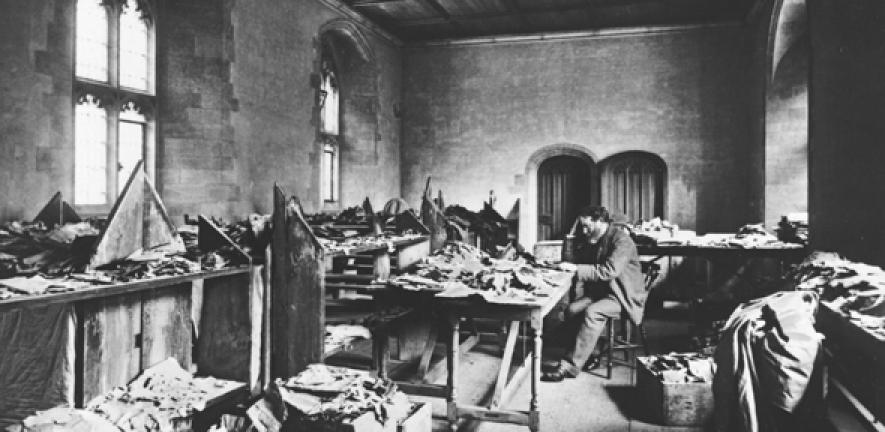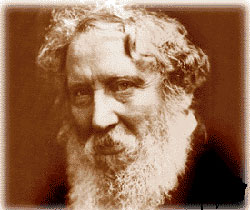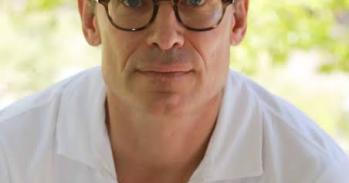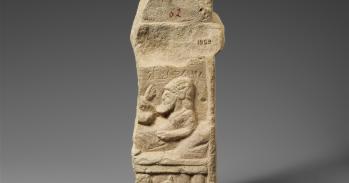
The Jewish scholar Solomon Schechter is best remembered for his work on the Cairo Geniza. A conference this Sunday will explore the wider impact of a man with an unquenchable thirst for learning.
The Jewish scholar Solomon Schechter is best remembered for his work on the Cairo Geniza. A conference this Sunday will explore the wider impact of a man with an unquenchable thirst for learning.
A dazzling intermediary between rabbinic and academic worlds, he wrote beautiful, pioneering essays for an appreciative Victorian readership
Theodor Dunkelgrün
Solomon Schechter was instantly recognisable in 1890s Cambridge. He was tall and untidily dressed, and he had an unruly red beard that matched his fiery personality. According to his friends, he seldom wore socks that matched in colour. People and conversations, Jewish history and books, were what mattered most to him.
In 1890 Schechter, a Romanian-born rabbi, became Lecturer in Talmudics at Cambridge. Together with his wife Mathilde he entertained a wide circle of people of different faiths. His Cambridge friends included the Presbyterian twin sisters, Agnes Lewis and Margaret Gibson, co-founders of Westminster College, William Robertson Smith of Christ’s, J Rendel Harris of Clare, and Charles Taylor of St John’s.
His closest friend was the reclusive James Frazer of Trinity, author of The Golden Bough, a monumental comparative study of folklore, magic and religion, who proof-read Schechter’s essays and with whom Schechter liked to take long walks.
To mark the centenary of Schechter’s death, scholars are looking afresh at his remarkable life and afterlife - in particular at the contribution to scholarship made by a man with an omnivorous hunger for learning that drove him from the traditional Jewish Eastern-European world into which he was born to Vienna, Berlin, London, Cambridge and finally New York.

When he collapsed (and later died) after giving a lecture on Jewish philanthropy, his wife recounted that he asked for a book to read, protesting that “I can’t just lie down here doing nothing”.
A conference in Cambridge on Sunday, November 22, will bring together scholars from the USA, the UK, Europe and Israel to examine many aspects of Schechter’s life – from his work on ancient, medieval and modern Jewish history to his close relationships with his Cambridge contemporaries.
“Solomon Schechter was only the second Jew to be appointed to a teaching position at Cambridge. He was the quintessential absent-minded but brilliant scholar,” says Dr Theodor Dunkelgrün of CRASSH and St John’s College, who is convening the conference.
“He possessed a phenomenal intellect and was passionately interested not just in Jewish theology and history generally, but in all manner of literary, social, and cultural issues, including the role of women in Judaism, in ways that were way ahead of his time. A dazzling intermediary between rabbinic and academic worlds, he wrote beautiful, pioneering essays for an appreciative Victorian readership.”
It was a meeting with two of his Cambridge friends that won Schechter a place in history. In May 1896, Schechter was walking along King’s Parade when he met Agnes Lewis who, with her sister Margaret Gibson, had recently returned from Cairo where they had purchased a bundle of interesting documents. Lewis and Gibson, whose remarkable lives are vividly documented in Janet Soskice’s Sisters of Sinai, were self-taught scholars who had learnt Syriac in order to be able to read the earliest known versions of the Christian gospels.
Among the documents that Lewis and Gibson had acquired from a dealer in Cairo was a grubby scrap of paper which looked, in Gibson’s words “as if a grocer had used it for something greasy”. Schechter identified this fragment as part of a medieval copy of a hitherto unknown Hebrew original of the apocryphal book known as Ecclesiasticus to Christians and the Wisdom of Ben Sira to Jews. The incredible discovery suggested to him the possibility that there might well be more where it came from.
In accordance with Jewish law, no document containing the Holy Name may be destroyed. Jewish communities collect old texts beyond use in a so-called Geniza, a tomb for texts. The precious fragment of text that had, according to Gibson, made Schechter’s eyes glitter with excitement came from such a Geniza, a vast repository of documents stored, in haphazard fashion, in the oldest of Cairo’s synagogues, the Ben Ezra.
The discovery and importance for medieval history of this unique collection is told in riveting detail by Adina Hoffman and Peter Cole’s book Sacred Trash and in Stefan Reif’s A Jewish Archive from Old Cairo.
Sponsored by his friend Professor Charles Taylor, Master of St John’s College, Schechter travelled from Cambridge to Cairo, where, after winning the trust of the chief rabbi, he entered a windowless room that contained several hundreds of thousands of documents and manuscripts accrued, layer by dusty layer over a period of nearly a thousand years.
“A battlefield of books” is how Schechter described the chaos of handwritten manuscripts mingled with later printed text. Extraordinary as it may now seem, the chief rabbi authorised Schechter to take as much as he liked to deposit in Cambridge University Library. Schechter famously commented that he liked it all.
After spending a month trying to separate out the early material which mattered to him most, Schechter packed a “whole mass of rugged, jumbled, dirty stuff into huge sacks” which were dispatched to Cambridge. A black-and-white photograph reproduced in Sisters of Sinai shows Schechter sitting in a room in the old University Library surrounded by boxes brimming over with documents that range from love letters and children’s doodles to hymns and religious texts.
Today these 193,000 manuscript fragments make up the Taylor-Schechter Genizah Collection in the Cambridge University Library – a treasure trove that an ambitious digitisation project has recently made accessible to scholars worldwide.

Schechter is not surprisingly best remembered for his contribution to the preservation of an archive that offers a unique window onto daily life of the medieval Jewish past in the Islamic world. But his pioneering study of the Geniza was just one strand in a career that took him from the Hassidic milieu of the small Romanian town where he was born to the rarefied world of late-Victorian Cambridge, and eventually to America.
In 1902, Schechter left Cambridge to take up the chancellorship of the Jewish Theological Seminary of America in New York, where he helped shape a generation of scholars and communal leaders and became the unintentional founder of the movement now known as Conservative Judaism.
Dunkelgrün says: “Schechter’s name will always, and justly, be associated with the Geniza, but he was much more than a Geniza scholar – he was a polymath who cared passionately for the entirety of the Jewish tradition, mystical and rational, from antiquity to his own time and beyond, towards the future. He paired this panoramic vision both with the traditional rabbinical education he received at home, in Lemberg and in Vienna, and with the philological skills he acquired in Berlin to produce critical editions of several major Rabbinic texts.”
A postdoctoral research fellow at CRASSH, Dunkelgrün is contributing to a European Research Council-funded project on The Bible and Antiquity in 19th-century culture. He insists that Schechter’s work in Cambridge over a period of 20 years was made possible in large part because of the fascination of Victorian England, and Cambridge in particular, for biblical antiquity.
“Schechter cut an exotic figure, but one that was strangely at home in academic circles already convinced about the importance of rabbinic studies for the early history of Christianity. Schechter was the second in a line of six teachers of Rabbinics at Cambridge, the last of whom was Professor Nicholas de Lange, now formally retired from his post. We hope very much that this conference will draw attention not only to Schechter but also to this unique and precious tradition of Cambridge scholarship, and the importance of keeping it alive.”
Attendance at Sunday’s conference, Solomon Schechter’s Life and Legacy, is free of charge. Particulars and a link to registration may be found here: https://www.crassh.cam.ac.uk/events/26067/
Inset images: Solomon Schechter, before his death in 1915 (Wikimedia Commons); Solomon Schechter at work in the old University Library (Reproduced by kind permission of the Syndics of Cambridge University Library).

The text in this work is licensed under a Creative Commons Attribution 4.0 International License. For image use please see separate credits above.




